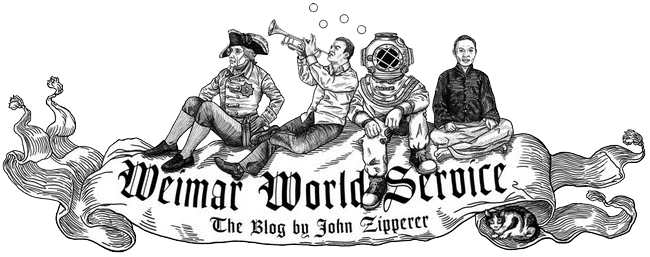Starlog #36
100 pages (including covers)
Cover price: $2.95
The cover design is a repeat of the blocked-photo layout last seen on the third-anniversary cover. We get another two-page From the Bridge column by publisher Kerry O'Quinn, but there's not a repeat of the two-page table of contents. (There is, however, another of Howard Zimmerman's photo collages illustrating the contents page.) Today it is not unusual for a niche-market magazine to have 100 or more pages in every issue (especially if it's published in the UK), but in 1980, it was a rare thing, certainly in the science-fiction media magazine field. So this special issue was an annual event.
Kerry O'Quinn's extra-long From the Bridge editorial looks at opening up avenues of exploration and intellectual stimulation — it's vintage O'Quinn, and in only the third issue of the magazine since I'd become a reader, it confirmed in my mind that this was my magazine, speaking to 12-year-old me; letters in the Communications section range from praise for the Tom Baker interview to comments on women in SF to follow-up on Rocky Jones to a high school mainframe computer user who discusses his Star Trek game; short news items in Log Entries include Star Wars characters guest starring on The Muppet Show, Bob Burns' time machine, Dr. Joseph Veverka on solar sails, an update on the Heavy Metal movie, first word on The Quatermass Conclusion, and more.
David Houston interviews Gary Kurtz, producer of The Empire Strikes Back (and who actually told Starlog, "Here's how it goes. There are nine stories: three trilogies of three stories each. Star Wars was the first story in the middle trilogy." Oops.); David Gerrold's Rumblings column "The Write Way," offers writing suggestions -- and he begins by relating his rejection of a young writer who asked for help, saying he can't offer it, yet then he goes on to offer writing help -- vintage Gerrold; Karen E. Willson interviews Star Trek's Nichelle Nichols; Willson also interviews Glen Larson, producer of Battlestar Galactica and Buck Rogers in the 25th Century (I'll bet he leaves Galactica 1980 off his resume).
In the special anniversary section, Samuel J. Maronie provides an overview of science-fiction television in the 1979-1980 season; there are photo reviews of recent films Alien, Star Trek -- The Motion Picture, The Black Hole, Saturn 3, Moonraker, and The Empire Strikes Back; there's a two-page SF collage by Howard Zimmerman (a detail of which was shown on the contents page); famous science-fiction professionals send in their anniversary congratulations to the magazine (such as illustrations by Jack Katz and Howard Cruse or Buster Crabbe's "Congratulations on your first four years. Yours has been an excellent job"); Jonathan Eberhart writes about the future of exploration in the solar system; a four-page space art section highlights some beautiful paintings by artists David Hardy and Gary LaSasso; Karen Willson and David Heath provide a roundup of upcoming science-fiction and fantasy offerings from the various production studios; Susan Adamo and John Clayton (who would soon be named the magazine's staff photographer, but is only listed as a contributor this issue) provide a three-page topic index to the last year of Starlogs.
Susan Adamo also interviews Durinda Rice Wood, the costume designer for the Battle Beyond the Stars motion picture; Gerry Anderson's Space Report completes its look at "The Mysterious Unknown Force," this time by printing letters from readers offering their interpretations; David Houston interviews Tom Leetch, co-producer of the Disney movie The Watcher in the Woods, starring Bette Davis; Samuel J. Maronie interviews Yvette Mimieux, star of The Black Hole; David Prowse (aka Darth Vader) is back for his third Starlog interview, armed with more complaints against the producers -- this time he's interviewed by David Hirsch; Frank Winter explores "Ye Olde Space Music," scores for classic SF films; an unbylined article examines science-fiction games; Al Taylor, Bill Hume and Mike Smith team up to write "Alien Worlds: Science Fiction Radio Rides Again"; David Houston's Visions column continues his look at "The Visual Art of SF Cinema" by examining the art of freeze frames ("... single shots that contain so much information, or information of such startling quality, they seem to slam right into the subconscious center of emotions"); and editor Howard Zimmerman uses his Lastword column to offer the First Annual Zimmerman/SF Awards (let's just say that Meteor does not fare well).
"Starlog, from the very start, set as one of our prime editorial goals, to be an intellectual inspiration to our readers. ... [W]oven into the fabric of the magazine, is an attitude toward new ideas, toward intellectual explorations, toward creativity and a bold, positive approach to life. This attitude is a vitally important ingredient of our publishing philosophy and, I believe, of our success."
--Kerry O'Quinn, publisher, From the Bridge: "Opening Doors"To view previous Starlog issue descriptions, click on "Starlog Internet Archive Project" in the keywords below.




No comments:
Post a Comment